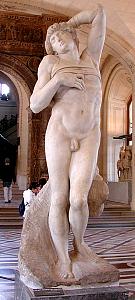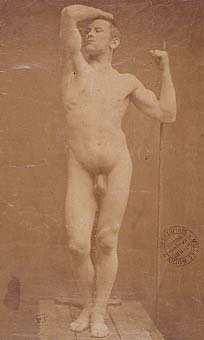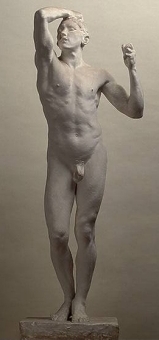|
In 1875, when the major decoration projects in Brussels
were nearing completion, Rodin started the work on a life-size male nude
after studies of a 22 years old Belgian soldier named Auguste Neyt. He titled it 'The
Vanquished' and intended to submit it to the Salon. After more than 20
years of apprenticeship and anonymity, he hoped to overcome his status as
a mere handworker and establish himself as a statuaire. Albert
Elsen draws attention to the conservatism of Rodin's aspirations: whereas
the word 'sculpture' is associated with the free-handed creations of Modernism, 'statues' were
life-size standing figures, created
with the intention to have them purchased and displayed by the state. But
exactly this denomiation was denied to Rodin's first attempt: "The
work of M. Rodin is a study, rather than a statue...", wrote the art
critic Tardieu in the magazine Art, in 1877.
 Rodin worked on the nude for 18 months. The progress of the work was interrupted by a trip to Italy in February and March 1876 where
Rodin admired the work of Michelangelo in a burst of
enthusiasm. When he returned to Brussels, he finished the sculpture and presented it at the
Cercle
Artistique. Rodin worked on the nude for 18 months. The progress of the work was interrupted by a trip to Italy in February and March 1876 where
Rodin admired the work of Michelangelo in a burst of
enthusiasm. When he returned to Brussels, he finished the sculpture and presented it at the
Cercle
Artistique.
Evidently, the pose was inspired by
Michelangelo's 'Dying Slave' (1514-16, marble, 90" high). Like
Michelangelo's work, Rodin's composition shows a console shape with bent
knees and a hollow chest, transmitting a certain expression of unsureness,
not to say effeminacy.
This impression of temptativeness was augmented by Rodin's decision to have
the spear removed from the character's left hand when his work was
exhibited in Brussels in January 1877. Originally, the model had been keeping a wooden staff in order to keep his
pose for an extended period of time.
But Rodin felt that this attribute interfered with the proper view of
his modelling, so that 'The Vanquished' was displayed with his
left arm suspended in the air. This not only added to the suggestion of
indecisiveness, but also deprived the sculpture of its proposed subject
matter of warfare.
|
Rodin's presentation
provoked consternation at the Cercle Artistique.
Rodin later defended his decision by stating he rather had wanted to
portray a psychological state instead of a literary anecdote: "We
notice that his sculpture expresses the painful withdrawal of the
being into himself, restless energy, the will to act without hope of
success, and finally the martyrdom of the creature who is tormented
by his unrealisable aspirations."
The musculature of this nude was modeled in a
plain naturalistic style without excessive hollows and projections.
"What he wanted was a natural attitude, as realistic as life",
remembered
Neyt. But in the press, the work was not only ridiculed for its vagueness
of subject: incredulous critics accused Rodin of having used plaster casts from
life - a method thought not worthy of an artist. In L'Etoile Belge of
29 Jan. 1877, an anonymous author wrote: |
 |
 |
"We do not need to examine here whether this plaster was modelled directly on the living
model. We simply wish to point out that the physical and moral dejection of this figure is rendered so expressively that without any indication other than the work
itself, it seems as if the artist wanted to represent a man on the point of committing
suicide."
The persistent artist submitted his work to the
1877 Paris Salon, again without the lance, this time under the title
'The Age of Bronze', only to learn the rumours from Belgium had followed
him.
In Spring 1877, an utterly frustrated Rodin wrote to Rose:
  "As you can imagine, I am extremely upset being so near to my
goal! My figure was considered to be so fine by everyone, and now they insist on saying it was modelled from life [...] . I am
demoralized, I am exhausted, I am short of money, I must look for a studio [...]." "As you can imagine, I am extremely upset being so near to my
goal! My figure was considered to be so fine by everyone, and now they insist on saying it was modelled from life [...] . I am
demoralized, I am exhausted, I am short of money, I must look for a studio [...]."
Rodin addressed the chairman of the jury, Eugène
Guillaume, director of the École des Beaux-Arts, for a chance to
clear his reputation:
"Owing to these terrible doubts raised
by the jury, I find myself robbed of the fruits of my labors. Contrary to
what people think I did not cast my figure from the model but spent a year
and a half on it; during that time my model came to the studio almost
constantly. Moreover I have spent my savings working on my figure, which I
had hoped would be as much of a success in Paris as it was in Belgium
since the modeling seems good - it is only the procedure that has been
attacked. How painful it is to find that my figure can be of no help to my
future; how painful to see it rejected on account of a slanderous
suspicion!"
His Belgian friends Félix Bouré and
Gustave Biot contributed testimonies that they had watched Rodin work on
his figure only from the living model. The artist also had photos made of
Auguste Neyt and his sculpture, to demonstrate that the accusations raised
in the Étoile Belge were false, but his evidence was completely
ignored by the jury.
As these pictures show, Rodin made the legs and lower torso of his figure slimmer than the features of the
model; he also made the head somewhat smaller.
To Gsell, Rodin himself later explained the difference between a surmoulage, a life plaster cast of the model, and his own approach as follows:
"Nevertheless,", I [=Paul
Gsell] answered with some malice, "it is not nature exactly as it is that
you evoke in your work." (...)
"But after all, the proof that
you do change it is this, that the cast would not give at all the same
impression as your work."
He reflected an instant and said. "That is so! Because the cast is
less true than my sculpture!
"It would be impossible for any model to keep an animated pose during
all the time that it would take to make a cast from it. But I keep
in my mind the ensemble of the pose and I insist that the model shall
conform to my memory of it. More than that, - the cast only reproduces the
exterior; I reproduce, besides that, the spirit which is certainly also a
part of nature.
"I see all the truth, and not only that of the outside.
"I accentuate the lines which best express the spiritual state that I
interpret.
As he spoke he showed me on a pedestal nearby one of his most beautiful
statues, a young man kneeling, raising suppliant arms to heaven. All his
being is drawn out with anguish. His body is thrown backwards. The breast
heaves, the throat is tense with despair, and the hands are thrown out
towards some mysterious being to which they long to cling.
"Look!" he said to me;
"I have accented the swelling of the muscles which express distress.
Here, here, there - I have exaggerated the straining of the tendons which
indicate the outburst of prayer."
And, with a gesture, he underlined the most vigorous parts of his work.
"I have you, Master!" I cried ironically; "You say yourself
that you have accented, accentuated, exaggerated. You see, then,
that you have changed nature."
He began to laugh at my obstinancy.
"No," he replied. "I have not changed it. Or, rather, if I
have done it, it was without suspecting it at the time. The feeling which
influenced my vision showed me Nature as I have copied her.  Paul Gsell, Rodin on Art and Artistst, Dover Publications, New York, p. 11
Paul Gsell, Rodin on Art and Artistst, Dover Publications, New York, p. 11
As long as he was haunted by the rumour of surmoulage, the road was not
cleared for Rodin's career as an artist sculptor.
On 11 January 1880, Rodin had an interview with Turquet, State Undersecretary
for Fine Arts, who wanted to commission a bronze cast of 'The Age of Bronze', but
needed an
expertise contradicting the accusations raised in Belgium. A commission
headed by deputy inspector Roger Ballu, however, did not believe Rodin had been able to model the work without surmoulage:
"This examination had convinced us that if this statue
is not a life cast in the absolute sense of the word, casting from life
early plays so prponderant a part in it that it cannot really be regarded
as a work of art.."
Together with
Turquet's protégé, Maurice Haquette, Rodin prepared a testimony, dated
23 February 1880, signed by the best-known sculptors of that time, confirming
Rodin's outstanding abilities. After this intervention,
'St. John the Baptist Preaching' and 'The Age of Bronze' are shown in the
Salon; the latter won a third-class medal and was finally purchased by the
state.
In August 1880, it won a gold medal in Ghent.
'The Age of Bronze' by now is a very widespread Rodin
work. It was realized in large, medium and small versions. The first
bronze cast was made by Thiébaut Frères. Allegedly, over 150
bronze casts have been produced by the Rudier Foundry later. The Fine art
Museum of Budapest owns a rare pappmaché version, which was authorised by Rodin.
BIBLIOGRAPHY (supplied by The
National Gallery of Art, Washington):
 "Chronique de la Ville." L'Etoile belge (29 January and 3 February 1877). "Chronique de la Ville." L'Etoile belge (29 January and 3 February 1877).
 Rousseau, Jean. "Revue des Arts." Echo du Parlement (11 April 1877). Rousseau, Jean. "Revue des Arts." Echo du Parlement (11 April 1877).
 Tardieu, Charles. "Le Salon de Paris--1877--La
Sculpture." L'Art 3 (1877): 108. Tardieu, Charles. "Le Salon de Paris--1877--La
Sculpture." L'Art 3 (1877): 108.
 Timbal, Charles. "La Sculpture au Salon." Gazette des Beaux-Arts (16 July 1877): 42-43. Timbal, Charles. "La Sculpture au Salon." Gazette des Beaux-Arts (16 July 1877): 42-43.
 Bartlett, Truman H. "Auguste Rodin,
Sculptor." American Architect andBuilding News (19 January-15 June 1889): 65, 99-100, 283-284. Bartlett, Truman H. "Auguste Rodin,
Sculptor." American Architect andBuilding News (19 January-15 June 1889): 65, 99-100, 283-284.
 Rilke, Rainer Maria. Auguste Rodin. Trans. in G. Craig Houston, Rodin and Other Prose
Pieces. London, 1986: 15-16. Rilke, Rainer Maria. Auguste Rodin. Trans. in G. Craig Houston, Rodin and Other Prose
Pieces. London, 1986: 15-16.
 Neyt, Auguste. Grand Artistique (April 1922). Neyt, Auguste. Grand Artistique (April 1922).
 Cladel, Judith. Rodin: sa vie
glorieuse, sa vie inconnue. Paris, 1936: 108, 114-121. Cladel, Judith. Rodin: sa vie
glorieuse, sa vie inconnue. Paris, 1936: 108, 114-121.
 Grappe, Georges. Catalogue du Musée Rodin. 5th ed. Paris, 1944: 15-16. Grappe, Georges. Catalogue du Musée Rodin. 5th ed. Paris, 1944: 15-16.
 Waldemann, Emil. Auguste Rodin.
Vienna, 1945: 22, 73. Waldemann, Emil. Auguste Rodin.
Vienna, 1945: 22, 73.
 Seymour, Charles. Masterpieces of Sculpture from the National Gallery of Art. Washington and New York, 1949: 184, note 56,
repro. 168. Seymour, Charles. Masterpieces of Sculpture from the National Gallery of Art. Washington and New York, 1949: 184, note 56,
repro. 168.
 Alley, Ronald. Tate Gallery
Catalogues. The Foreign Paintings, Drawings and Sculpture. London, 1959: 210-211. Alley, Ronald. Tate Gallery
Catalogues. The Foreign Paintings, Drawings and Sculpture. London, 1959: 210-211.
 Elsen, Albert E. Rodin. New York, 1963: 20-26. Elsen, Albert E. Rodin. New York, 1963: 20-26.
 Summary Catalogue of European Paintings and
Sculpture. National Gallery of Art, Washington, 1965: 168. Summary Catalogue of European Paintings and
Sculpture. National Gallery of Art, Washington, 1965: 168.
 Descharnes, Robert, and Jean-François
Chabrun. Auguste Rodin. Lausanne, 1967: 52-54. Descharnes, Robert, and Jean-François
Chabrun. Auguste Rodin. Lausanne, 1967: 52-54.
 Spear, Athena Tacha. Rodin Sculpture in the Cleveland Museum of Art. Cleveland, 1967: 39-40, 94-95. Spear, Athena Tacha. Rodin Sculpture in the Cleveland Museum of Art. Cleveland, 1967: 39-40, 94-95.
 European Paintings and
Sculpture, Illustrations. National Gallery of Art, Washington, 1968: 148,
repro. European Paintings and
Sculpture, Illustrations. National Gallery of Art, Washington, 1968: 148,
repro.
 Tancock, John. The Sculpture of Auguste Rodin. Philadelphia, 1976: 342-356. Tancock, John. The Sculpture of Auguste Rodin. Philadelphia, 1976: 342-356.
 de Caso, Jacques, and Patricia B. Sanders. Rodin's
Sculpture: A Critical Study of the Spreckels Collection. San Francisco, 1977: 38-47. de Caso, Jacques, and Patricia B. Sanders. Rodin's
Sculpture: A Critical Study of the Spreckels Collection. San Francisco, 1977: 38-47.
 Butler, Ruth. "Nationalism, a New
Seriousness, and Rodin: Thoughts about French Sculpture in the 1870s." In
H.W. Janson, ed. La Sculptura nel XIX Secolo. Bologna, 1979: 161-167. Butler, Ruth. "Nationalism, a New
Seriousness, and Rodin: Thoughts about French Sculpture in the 1870s." In
H.W. Janson, ed. La Sculptura nel XIX Secolo. Bologna, 1979: 161-167.
 Butler, Ruth. Rodin in
Perspective. Englewood Cliffs, New Jersey, 1980: 32-35. Butler, Ruth. Rodin in
Perspective. Englewood Cliffs, New Jersey, 1980: 32-35.
 Elsen, Albert E. In Rodin's Studio.
Ithaca, New York, 1980: 157-158, pls. 2-5. Elsen, Albert E. In Rodin's Studio.
Ithaca, New York, 1980: 157-158, pls. 2-5.
 Butler, Ruth. "Rodin and the Paris Salon." In Rodin
Rediscovered. Exh. cat. National Gallery of Art, Washington, D.C., 1981: 33-34. Butler, Ruth. "Rodin and the Paris Salon." In Rodin
Rediscovered. Exh. cat. National Gallery of Art, Washington, D.C., 1981: 33-34.
 Vincent, Clare. "Rodin at the Metropolitan Museum of Art: A History of the
Collection." The Metropolitan Museum of Art Bulletin (Spring 1981): 24. Vincent, Clare. "Rodin at the Metropolitan Museum of Art: A History of the
Collection." The Metropolitan Museum of Art Bulletin (Spring 1981): 24.
 Schmoll, J.A.
Rodin--Studien: Persönlichkeit--Werke--Wirkung--Bibliographie. Munich, 1983: 53-56. Schmoll, J.A.
Rodin--Studien: Persönlichkeit--Werke--Wirkung--Bibliographie. Munich, 1983: 53-56.
 Grunfeld, Frederic V. Rodin: A
Biography. New York, 1987: 98-106, 113-114, 125-129. Grunfeld, Frederic V. Rodin: A
Biography. New York, 1987: 98-106, 113-114, 125-129.
 Ambrosini, Lynne, and Michelle
Facos. Rodin: The Cantor Gift to the Brooklyn Museum. Brooklyn, 1987: 56-58. Ambrosini, Lynne, and Michelle
Facos. Rodin: The Cantor Gift to the Brooklyn Museum. Brooklyn, 1987: 56-58.
 Fonsmark, Anne-Birgitte. Rodin: La collection du Brasseur Carl Jacobsen à la
Glyptothèque. Copenhagen, 1988: 67-69. Fonsmark, Anne-Birgitte. Rodin: La collection du Brasseur Carl Jacobsen à la
Glyptothèque. Copenhagen, 1988: 67-69.
 Goldscheider, Cécile. Auguste Rodin: catalogue raisonné de l'oeuvre
sculpté. Lausanne, 1989: 114-116. Goldscheider, Cécile. Auguste Rodin: catalogue raisonné de l'oeuvre
sculpté. Lausanne, 1989: 114-116.
 Butler, Ruth. Rodin. The Shape of Genius. New Haven and London, 1993: 99-112. Butler, Ruth. Rodin. The Shape of Genius. New Haven and London, 1993: 99-112.
 Sculpture: An Illustrated
Catalogue. National Gallery of Art, Washington, 1994: 199, repro. Sculpture: An Illustrated
Catalogue. National Gallery of Art, Washington, 1994: 199, repro.
 Kausch, Michael. Auguste Rodin: Eros und Leidenschaft.
Exh. cat. Harrach Palace, Kunsthistorisches Museum, Vienna, 1996: 252-254. Kausch, Michael. Auguste Rodin: Eros und Leidenschaft.
Exh. cat. Harrach Palace, Kunsthistorisches Museum, Vienna, 1996: 252-254.
 Le Normand-Romain, Antoinette. Vers l'Age
d'airain: Rodin en Belgique. Paris, 1997: 246-319. Le Normand-Romain, Antoinette. Vers l'Age
d'airain: Rodin en Belgique. Paris, 1997: 246-319.
 Porter, John R., and Yves
Lacasse. Rodin à Québec. Quebec, 1998: 58-59. Porter, John R., and Yves
Lacasse. Rodin à Québec. Quebec, 1998: 58-59.
 Butler, Ruth, and Suzanne Glover Lindsay, with Alison Luchs, Douglas Lewis, Cynthia J. Mills, and Butler, Ruth, and Suzanne Glover Lindsay, with Alison Luchs, Douglas Lewis, Cynthia J. Mills, and
 Jeffrey Weidman. European Sculpture of the Nineteenth
Century. The Collections of the National Gallery of Art Systematic
Catalogue. Washington, D.C., 2000: 315-317, color repro. Jeffrey Weidman. European Sculpture of the Nineteenth
Century. The Collections of the National Gallery of Art Systematic
Catalogue. Washington, D.C., 2000: 315-317, color repro.
|